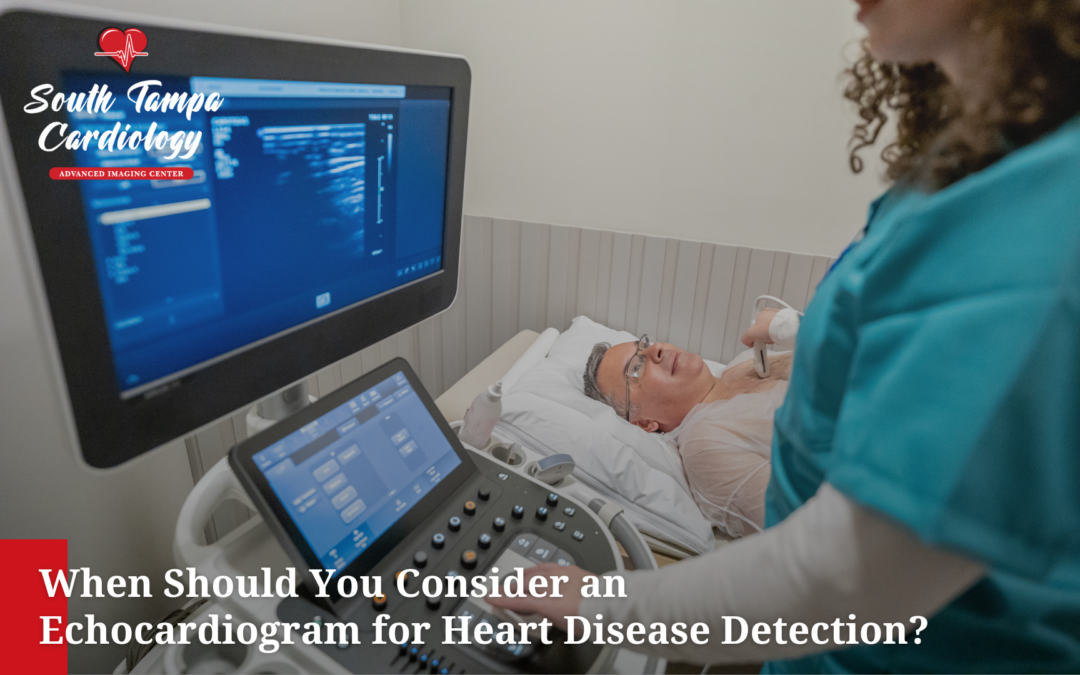When we think about heart disease, we often imagine symptoms such as chest pain or shortness of breath. However, in reality, many heart conditions develop without any major signs. That’s why it’s important to carefully monitor your heart health with preventive tools like echocardiograms. This simple, non-invasive test delivers real-time images of your heart, allowing you to pinpoint problems before they escalate. In this blog, we’ll take a closer look at what echocardiograms are, how they work, and how our South Tampa cardiologist can help protect your long-term heart health.
What is an Echocardiogram and How Does It Help Detect Heart Disease?
An echocardiogram, often referred to as an “echo,” uses ultrasound (or high-frequency sound waves) to produce images of your heart. Through this highly accurate imaging, cardiologists can identify the following heart problems:
- Congenital heart disease: Congenital defects are structural problems that are present at birth, such as holes in the heart walls or abnormally formed valves.
- Cardiomyopathy: This disease impedes the heart’s ability to pump blood, leading to enlarged or stiff heart chambers.
- Infective endocarditis: In this condition, patients experience bacterial infections in the heart’s inner lining or valves.
- Pericardial disease: Pericardial disease refers to disorders that affect the pericardium, or the thin sac surrounding the heart.
- Valve disease: This condition occurs when the heart’s valves don’t open or close properly, preventing proper blood flow.
- Blood clots: Blood clots may form inside the heart, increasing the risk of stroke.
- Aortic aneurysms: Characterized by a weakened aortic wall, this condition affects blood flow from the heart.
- Heart failure: Heart failure refers to any condition in which the heart cannot effectively pump blood.
The Importance of Early Detection: Why You Should Consider an Echocardiogram
When it comes to heart problems, it’s best to identify them sooner rather than later. Here are some major benefits of early detection:
- Reduced risk of serious complications: Early detection can help catch problems before they grow, reducing the risk of heart attacks, strokes, and heart failure.
- Personalized care plans: Echocardiograms give cardiologists the information they need to deliver personalized treatment plans.
- Peace of mind: As mentioned earlier, many people don’t experience warning signs of heart disease. Preventive care provides valuable peace of mind by checking for “invisible” symptoms.
Key Indicators for an Echocardiogram: When to Schedule the Test
While anyone can benefit from preventive cardiovascular care, some people may need it more than others. You should consider scheduling an echocardiogram if you meet any of the following factors:
- You have symptoms of heart disease: Common symptoms include shortness of breath, chest pain, heart palpitations, and swelling in the lower body.
- You have heart disease risk factors: You may have a higher risk of developing heart disease if you have high cholesterol, high blood pressure, or a family history of heart disease. Tobacco use and an unhealthy diet can also increase your risk.
- You already have a heart condition: If you have a diagnosed heart condition (such as valve disease), echocardiograms can help monitor your progress.
How an Echocardiogram Works: What to Expect During the Test
Now that you know the benefits of an echocardiogram, you might be wondering: How does it work? This depends on the type of echocardiogram you’re getting. There are two main versions: transthoracic echocardiograms (TTEs) and transesophageal echocardiogram (TEEs).
TTEs are the most common type of echocardiogram. During the procedure, you’ll lie down on an exam table while the cardiologist attaches electrodes (or small patches) to your chest. Then, the cardiologist will press an ultrasound wave to your chest to produce images. The procedure is minimally invasive, and there’s no special preparation needed.
If the cardiologist suspects heart problems, they may recommend a TEE. This procedure involves inserting a long, thin tube down the esophagus to capture clearer images. While a TEE more invasive than a TTE, it provides much more detailed imagery.
Understanding the Results: What Your Echocardiogram Can Tell You
Echocardiograms provide lots of valuable details regarding your heart health, including the following:
- Heart size and shape
- Blood flow and pumping strength
- Valve function
- Heart muscle damage
- Fluid buildup
With this information, your cardiologist can confirm or rule out current heart conditions. They can also identify early warning signs of heart disease and suggest treatments to help protect your heart. Treatments often involve a combination of lifestyle changes, medication, and further imaging. In more serious cases, you may need surgical intervention.
Why South Tampa Cardiology Recommends Echocardiograms for Comprehensive Heart Health Monitoring
Are you interested in getting an echocardiogram in Tampa? At South Tampa Cardiology, we use advanced technology to identify and treat a wide range of cardiovascular issues, from congenital defects to valve diseases. Not only do we help catch problems, but we also deliver highly personalized, effective treatment plans. Take control of your heart health by scheduling an appointment today!

